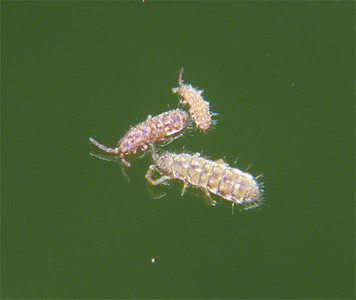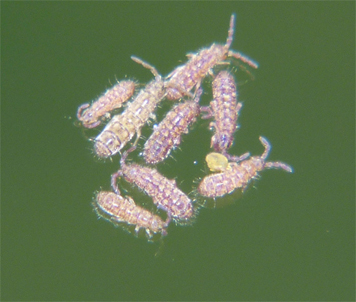It was Leon Bradford, Insectarium Manager at the Museum, who first discovered them. Dogged, persistent, Leon was determined to find insect activity on that cold December day. It was supposed to be a warm day, but the clouds lingered longer than predicted and the temps hovered in the thirties throughout the morning. I had told Leon that I hadn’t seen much insect activity (not even a Yellowjacket or fly on the Fatsia on the Dinosaur Trail) for several days. Seeing only one very sluggish insect in the water of the Wetlands that morning, things didn’t look good.
We had walked through Explore the Wild and were now at the Sailboat Pond in Catch the Wind. Only days before there had been many Backswimmers and a few Water Boatmen in the Sailboat Pond, but a search along the pond’s edge revealed only the exoskeletal remains of each of those two aquatic insects lying on the bottom of the shallow pond.
It was now afternoon and the sun had come out from behind the clouds; perhaps this would stir things up a bit. After some time, Leon noticed something floating at the edge of the pond. Dozens of tiny creatures were floating singly or in clusters on top of the water. The largest of those little creatures was 2-3 mm in length. Some of them appeared to be jumping or hopping on the water’s surface. Could they be springtails?

Springtails are in a different class of arthropod as are the beetles, bees, flies, and various other orders of arthropods that we’re all familiar with. At one time they were placed in the order Thysanura with silverfish, those tiny gray creatures with long antennae and three long thin “tails” that crawl out of seldom read books in our bookcases when we finally do get around to opening one of them (they’re after the starchy glue in the binding).
Among the springtails, there are three orders: Poduromorpha, Entomobryomorpha, and Symphypleona. It looks to me as if the latter two of those orders was represented on the pond that rather chilly day in December. Most, were long-bodied springtails in the family Isotomidae (Entomobryomorpha). Other, smaller, yellow objects floating with them seemed to be springtails in the order Symphypleona.

Springtails are so named because of a tail-like structure called a furcula which is normally held, under tension, folded under the rear of the body. When the furcula is released the springtail is sent flying through the air. Unfortunately, none of the images that I was able to get show the tail structure. This link shows an image of a springtail under a microscope. Here’s another.
Springtails typically live in the leaf liter or soil feeding on fungi, bacteria and decaying plant material. They can be quite numerous in the proper habitat. One account that I’ve read states that there can be “300 million to 1.4 billion per acre depending on factors such as humidity and organic matter content.” That’s a lot of springtails!
If you’ve lived in an area of the country where it snows often, you may have heard of “Snow Fleas.” Snow Fleas are actually springtails that have climbed up tree trunks, plant stems, or rocks to the surface of the snow. Their resemblance to fleas (they’re small and they jump) is what gives them the name Snow Flea. Different species can be found in the Arctic, Antarctic, and all places in between where there happens to be snow.
How did our springtails end up on the surface of the Sailboat Pond. I don’t know for sure, but as suggested by Leon, they probably got there on the leaf litter that was blown into the pond by the wind. Although there’s no way to be sure, that explanation sounds reasonable to me. I’ve seen many accounts and photos of springtails floating on water. Some of those were aquatic springtails, others not. Some were in swimming pools, some in aquaria. The only thing that seems certain is that springtails are very common and very adaptable.